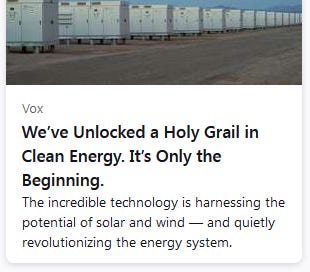Utility grid battery storage 2025
When will clean energy move beyond lithium-ion?
An article in Vox explores the rapid growth of grid-scale lithium-ion battery storage in the U.S., attributed to reduced costs, technological advancements, and policy changes. These batteries contribute to clean energy by stabilizing renewable power (solar/wind), improving grid reliability, and reducing reliance on fossil fuels. Key developments include a fivefold increase in battery capacity (2021–2024), integration with renewables for 84% of new U.S. power projects in 2024, and their role in enabling microgrids and resilience against climate disruptions.
Microgrids are localized energy systems that can operate independently or in conjunction with the main power grid. They provide reliable, sustainable, and often more affordable energy.
Some notable accomplishments in microgrids include:
Block Island, Rhode Island: Became the first U.S. community with a fully operational microgrid in 2017, powered by solar panels, wind turbines, and a diesel generator.
Brooklyn Navy Yard, New York: Hosts a microgrid that provides backup power to critical facilities like the NYC Fire Department’s training academy.
Puerto Rico: After Hurricane Maria in 2017, several microgrids were developed to improve the island’s power reliability, including one at the University of Puerto Rico Medical Sciences campus.
Kenya: Leading Africa in microgrid development, with a goal of 100,000 microgrids by 2025 to provide power to underserved rural communities.
Australia: Byron Bay operates a microgrid powered by solar panels, wind turbines, and batteries, reducing reliance on fossil fuels and improving air quality.
Key points regarding utility grid battery storage, as reported by Vox Media article:
Exponential Growth: U.S. grid battery capacity surged fivefold between 2021 and 2024, reaching over 26 gigawatts—now surpassing pumped hydro storage. Installations in 2024 alone achieved 12.3 gigawatts, with 2025 projected to nearly double that.
Cost and Tech Breakthroughs: Lithium-ion battery prices have reduced from ~$3,000/kWh (2008) to $150–$200/kWh (2024), driven by manufacturing scale (notably in China) and improvements from EVs and consumer electronics.
Grid Stability and Renewables: Batteries provide critical services like frequency regulation, peak shaving, and backup power, enabling higher renewable adoption (solar+storage accounted for 84% of new U.S. power in 2024) and reducing grid upgrade costs by smoothing demand spikes.
While the article seems to provoke with sensationalism, I would say geothermal would be best suited for energy production. To me, geothermal power plant generation represents the future of clean energy. -Marky
Furthering energy transition regarding utility storage batteries: Policy shifts (e.g., FERC Order 841) and state storage targets accelerated deployment, while challenges remain around long-duration storage, supply chain dependencies, and regulatory uncertainties.





